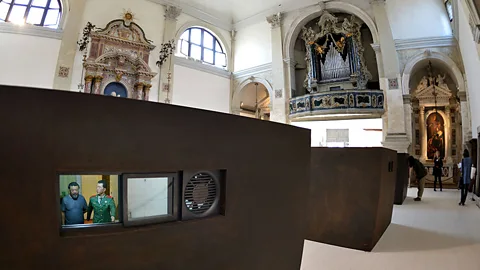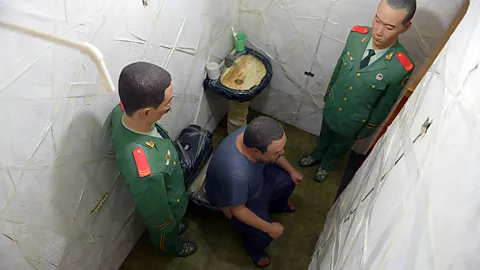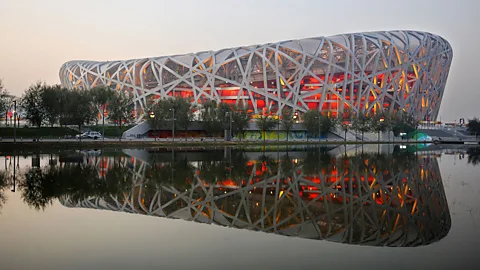Ai Weiwei: The most important artist alive?


Ai Weiwei became world famous after his arrest in 2011 – but how good is the art he makes? Alastiar Sooke takes a look.
One of the most memorable, and chilling, works of art that I saw at the Venice Biennale last year was S.A.C.R.E.D by the dissident Chinese artist Ai Weiwei, whose largest solo show to date is about to open in the Martin-Gropius-Bau in Berlin.
Arranged within the Baroque interior of the church of Sant’Antonin were six large and ominous black steel boxes, each one weighing almost two and a half tonnes. Inside these containers, a series of distressing tableaux involving highly realistic, half-life-size fibreglass figures and models was visible via small apertures cut into the metal. Each scene recorded a different moment from the artist’s secret detention in a military police base in the suburbs of Beijing in 2011.
Following his arrest at the Beijing Capital Airport on 3 April of that year, when a black hood was placed over his head, Ai was held in captivity in a cell measuring 7.2m by 3.6m (23.6ft by 11.8ft) for 81 days. Throughout his incarceration, the windows were blocked, the lights were on for 24 hours a day and he was accompanied at all times by two officers who monitored his every move, as did three surveillance cameras. For the first 30 days, he was forced to wear handcuffs, and, until his release on 22 June, following 51 interrogations in which he was accused of “inciting subversion of state power”, he was never given a change of clothes.

In S.A.C.R.E.D., the daily ordeals of Ai’s imprisonment are documented with sickening attention to detail. We see the artist sitting shackled and stony-faced before a couple of interrogators. Elsewhere, he eats, showers and uses the toilet, all the while accompanied by two stern guards in green uniforms standing within feet of him. The sense of bullying oppression, of the state systematically stamping upon the rights of an individual, is relentless and loathsome. Later this month, S.A.C.R.E.D will be shown for the first time since Venice as part of the new exhibition Ai Weiwei: According to What? at the Brooklyn Museum in New York.
To be seen and heard
What had Ai done to incur the wrath of the Communist Party of China? After all, for many people around the world, he was initially known for his collaboration with the Swiss architecture firm Herzog and de Meuron on the design of the Beijing National Stadium, or ‘Bird’s Nest’, which was built for the 2008 Olympic Games.
Born in 1957, the son of the modern Chinese poet Ai Qing, he grew up in a distant northwest province in the Gobi desert where his father, who had been banished there during the Cultural Revolution, was forced to clean public toilets in a village as punishment for his writing, which criticised the communist regime. “When we grew up we had no chance for any form of freedom of expression,” Ai said in an interview in 2006 published in the book Ai Weiwei Speaks – yet dissidence was in his blood.

In 1981, having started out as a painter, he flew to the United States, where he lived for the next 12 years and came of age as an artist, encountering the work of Duchamp and Warhol, who would both become touchstones for him. Following his return to China in 1993, he continued to refine his art, which encompasses many different media, including architecture, sculpture, photography and the internet. Unifying his outspoken conceptual work, which has a powerful political component, is the unshakeable conviction that the autonomy of the individual is non-negotiable.
As a result, although he was invited to work on the Bird’s Nest stadium, over time Ai adopted an increasingly critical stance towards the ruling Communist Party. In 2008, he was dismayed by the government’s response to the catastrophic earthquake that killed 70,000 people in Sichuan province. In particular, he was appalled that corrupt local authorities had allowed the construction of shoddy schoolhouses, exacerbating the loss of life.
To shed light upon this scandal, he and his assistants trawled scrap yards and acquired tonnes of the mangled steel rods that had been used to build the schoolhouses, before painstakingly straightening them with hammers in his studio, and presenting them as a work of art. Titled Straight, this was also shown in Venice last year, to complement the exhibition of S.A.C.R.E.D.
Swept under the rug
Eventually, Ai’s provocations became so open, and his international influence so extensive, that, in 2009, Chinese police attacked him during a night raid on his hotel room, when he suffered a brain haemorrhage. That same year, his blog, which was being visited by more than 100,000 people every day, was shut down. Two years after that, he endured the imprisonment that led to the creation of S.A.C.R.E.D. The subtitle spells out the acronym of the title, which refers to Ai’s existence in the cell: “(i) Supper (eating), (ii) Accusers (interrogation), (iii) Cleansing (shower), (iv) Ritual (walking), (v) Entropy (sleep), (vi) Doubt (toilet)”.

What sort of a man has Ai become as a result of his persecution? Greg Hilty, Curatorial Director at Lisson Gallery, which will mount an Ai Weiwei exhibition of its own in London in May, has known Ai since 2010 and visits him regularly in Beijing. “It’s hard to sum up a complex character in a few words,” Hilty tells me. “He is charismatic but gentle, fiercely intelligent but unpretentious and subtle and mercurial in his thought but also very clear in his expression. I have seen him both tender and in a rage, like a force of nature – the latter after a visit to the police who were questioning his wife.”
One thing is certain: even though his passport has been confiscated and he is now under constant surveillance by China’s secret police, Ai is unlikely to be cowed – as the creation of S.A.C.R.E.D suggests. “Apart from propelling him more fully into the global political and cultural arena,” Hilty says, “I believe his detention had a very personal and deep impact: after all, it was a long time, and he was all alone with no sense of the outcome, so it was a moment of existential fear and self-reflection. Coming out of it was like coming out of the fire: he is stronger.”
